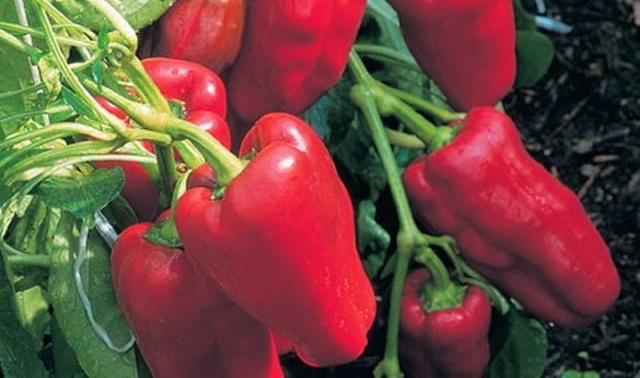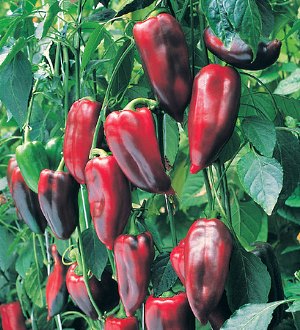 Pepper "Pinocchio" is considered one of the undersized varieties and low yielding, but, he is recognized as one of the best among sweet counterparts in terms of taste. In the garden, such a culture stands out for its unusual color.
Pepper "Pinocchio" is considered one of the undersized varieties and low yielding, but, he is recognized as one of the best among sweet counterparts in terms of taste. In the garden, such a culture stands out for its unusual color.
Content
Grade description
This pepper belongs to the early maturing varieties. It is unpretentious in cultivation and is suitable both for open ground and for a greenhouse. The stem usually does not reach a length of more than 70 cm. The structure of the plant is strong, usually gives 2-3 shoots. The leaves are small and have a dark green color. Fruits have a large conical shape or simply elongated. The weight of one pepper is from 80 to 130 g, and its size is approximately 18 cm in length and 7-8 in width. At the time of full ripening, the fruits are painted in gradient shades from dark red to wine or burgundy, sometimes spotting can be seen on the vegetable. The walls have a width of 5 mm. Such a culture grows sprawling and in a drooping position.
Attention: Temperate latitudes are ideal for landing Pinocchio. This early variety will perfectly take root in the European territory of Russia, Ukraine and Belarus. With proper care, such a culture can also sprout successfully in Siberia.
Features during planting and care
 The ultra-ripe hybrid of pepper begins to bear fruit already on the 90th day after planting on the garden bed, and in greenhouse conditions you can expect a crop by 80 days. Seeds for seedlings should be planted in separate small pots at the beginning of March. Dives in the phase of one sheet. You can plant a plant in open ground from mid-May to June. The distance between the holes should be 35-40 cm, and between the beds 50 cm. The plant does not need a garter. Harvesting occurs in July - mid-September, depending on the region of cultivation.
The ultra-ripe hybrid of pepper begins to bear fruit already on the 90th day after planting on the garden bed, and in greenhouse conditions you can expect a crop by 80 days. Seeds for seedlings should be planted in separate small pots at the beginning of March. Dives in the phase of one sheet. You can plant a plant in open ground from mid-May to June. The distance between the holes should be 35-40 cm, and between the beds 50 cm. The plant does not need a garter. Harvesting occurs in July - mid-September, depending on the region of cultivation.
Pepper characterization
The ripe fruits of Pinocchio are distinguished by a deep rich red-burgundy color. Coloring is often found not monophonic, but with transitions or spots. Due to its excellent taste, the pepper is perfect for conservation. Fruits have good shelf life and are not injured during transport. Pepper is also immune to apical rot and tobacco mosaic. Such a plant is rich in vitamin C, B, PP and sucrose.
Advice
- In order for the pepper to bring a high yield, it is worth providing it with sunlight or artificial light for at least 12 hours a day, this is especially important for seedlings. The soil should be warmed up to 15 degrees. Water the plant's germ with warm water and avoid drafts.
- Plants can be planted in open ground when they are not threatened by sudden frosts from May to mid-June. A warm day is suitable for transplantation, and the time is after 12 noon.
- Care includes important points, such as: loosening the soil, watering, fertilizers. It is necessary to water the plant as the top layer of the earth dries up, but in no case drought conditions should be allowed.
- To fertilize such a culture is recommended 2-3 times for the entire growth period. Top dressing should include nitrogen, phosphorus and potassium.
It's important to know: Buratino pepper is recommended to be planted at a distance from other varieties, as a self-pollinated plant it can acquire the taste of other plant species.
Reviews
Anna
Pepper is wonderful in taste and appearance. I cook from it pickles for the winter, the family is delighted!
Evgeniy
If you grow Pinocchio in rainy and windy summers, then it should be tied up, otherwise after severe thunderstorms you can lose your crop.
Helena
The best variety for spins, stuffings and fresh consumption. The pepper is so sweet that it quickly gobbles up even from the garden. When growing problems did not experience, the plant solidly grew.
If you follow all the rules, then the early-ripe variety “Pinocchio” will please with a premature harvest, and regular watering and fertilizing the soil will favorably affect its taste.




 Calorie pepper stuffed with meat and rice - BZHU per 100 grams
Calorie pepper stuffed with meat and rice - BZHU per 100 grams Gorky pepper - the best varieties for open ground
Gorky pepper - the best varieties for open ground Hot pepper seeds - the best varieties for open ground and reviews
Hot pepper seeds - the best varieties for open ground and reviews Capsicum tincture for hair - how to use and reviews
Capsicum tincture for hair - how to use and reviews